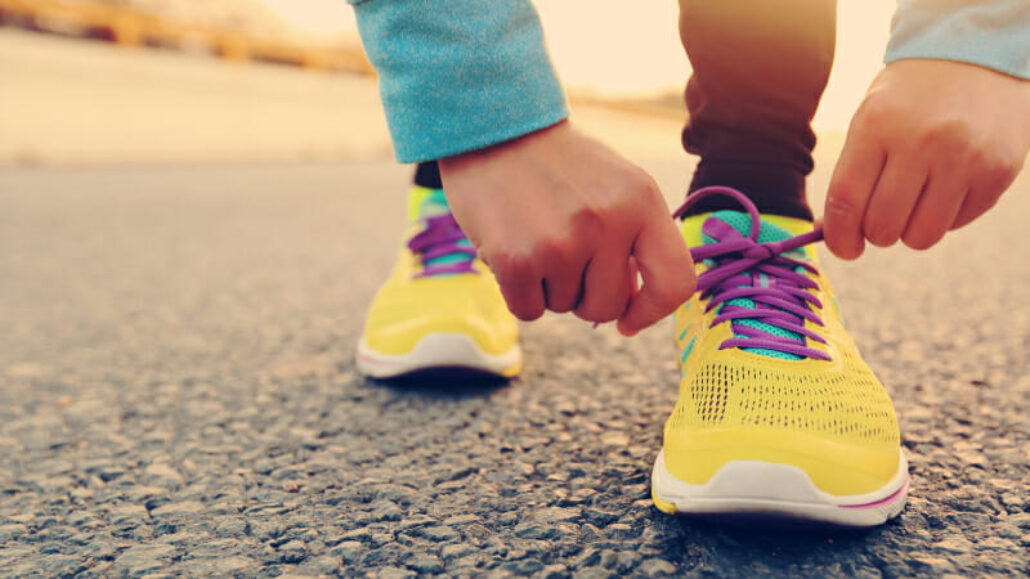Runners swear by their shoes, and for good reason. The type of shoe a runner wears may affect performance, and can make a difference between a running career marked by victories—or by repeated injuries.
Running is a high injury sport
“Running is a very high injury sport,” says Dr. Scofield. “About a quarter of runners who sign up for marathons don’t show up at the start line. During my sports medicine fellowship, we did a study of people who registered, but did not show up, for the Twin Cities Marathon. Of those, 67 percent, or about two-thirds, were unable to compete due to an injury in their training process.
Incidence of runner injury is much higher than it is for cyclists, swimmers, or basketball players. “There’s something about the impact of running that makes runners more prone to injuries, chronic tendinopathies, and stress fractures,” says Dr. Scofield. “Most injuries are the result of training error, or to the mechanics of how someone runs—but the type of new running shoe you wear can make a difference.”
Choosing a new running shoe
There are a variety of running shoe styles available, and Dr. Scofield assesses them based on whether they have a high or low “heel to toe drop.” Traditional highly cushioned shoes have a higher heel to toe drop; minimalist shoes with a flat sole have a low heel to toe drop.
“The shoe you choose should be tailored to your physical condition, and any injuries you might have,” explains Dr. Scofield. “As a runner, I have a specific type of Achilles tendinopathy that doesn’t do well in a flat running shoe with little or no cushion. I run in light trainers that have a fairly high heel to toe drop. I’ve tried to transition to a trainer with a lower heel to toe drop, but this causes problems for my insertional Achilles tendinopathy, and makes it harder for me to wear lighter shoes.”
Dr. Scofield explains that for other conditions like runners knee, or patella femoral pain syndrome (one of the most common runners problems), a lighter shoe with a lower heel can be beneficial. “A shoe with a lower heel can take some of the stress off the knees, especially if these runners also focus on moving to more of a midstrike pattern while increasing their cadence. The key is to transition to a new shoe very gradually.”
Make the change to a new shoe gradual
When one of Dr. Scofield’s patients is going to change into a shoe that is significantly different, he has them run for a minute in their new shoes, walk for a minute, and repeat for about 5 minutes. Then, they change back into the old shoes for the rest of the workout. “The next day,” says Dr. Scofield, “we increase the initial period in the new shoe slightly, so that we are gradually increasing the total amount of time a patient spends in the new shoe.”
When you choose a running shoe that supports your physical condition and transition into your new shoes gradually, you can maximize your running performance, and minimize the risk of injury.
Summit Orthopedics offers personalized foot and ankle expertise
Our fellowship-trained foot and ankle physicians understand that your mobility depends on the health of your feet and ankles. If you have suffered an injury or are experiencing symptoms that make walking painful, our team of foot and ankle specialists can help with conservative treatment, seasoned surgical teams, and expert rehabilitation support. Summit Orthopedics specialists have the expertise to evaluate your discomfort and develop a plan to quickly and safely get you back on your feet and on your way.
Start your journey to optimal foot health. Find your foot and ankle expert, request an appointment online, or call us at (651) 968–5201 to schedule a consultation.
Summit has convenient locations across the Minneapolis-St. Paul metro area, serving Minnesota and western Wisconsin. We have state-of-the-art centers for comprehensive orthopedic care in Eagan, MN, Plymouth, MN, Vadnais Heights, MN, and Woodbury, MN, as well as additional community clinics throughout the metro and southern Minnesota.
More resources for you:
- Ask Dr. Scofield: What Can Runners Do To Reduce The Risks Of Achilles Tendinopathy?
- Are Your Shoes Dangerous To Your Foot Health?
- Ask Sam Olson: Should Running Shoes Be Based On Arch Shape?
- Ask Sam Olson: How Do I Find The Right Running Shoe?

